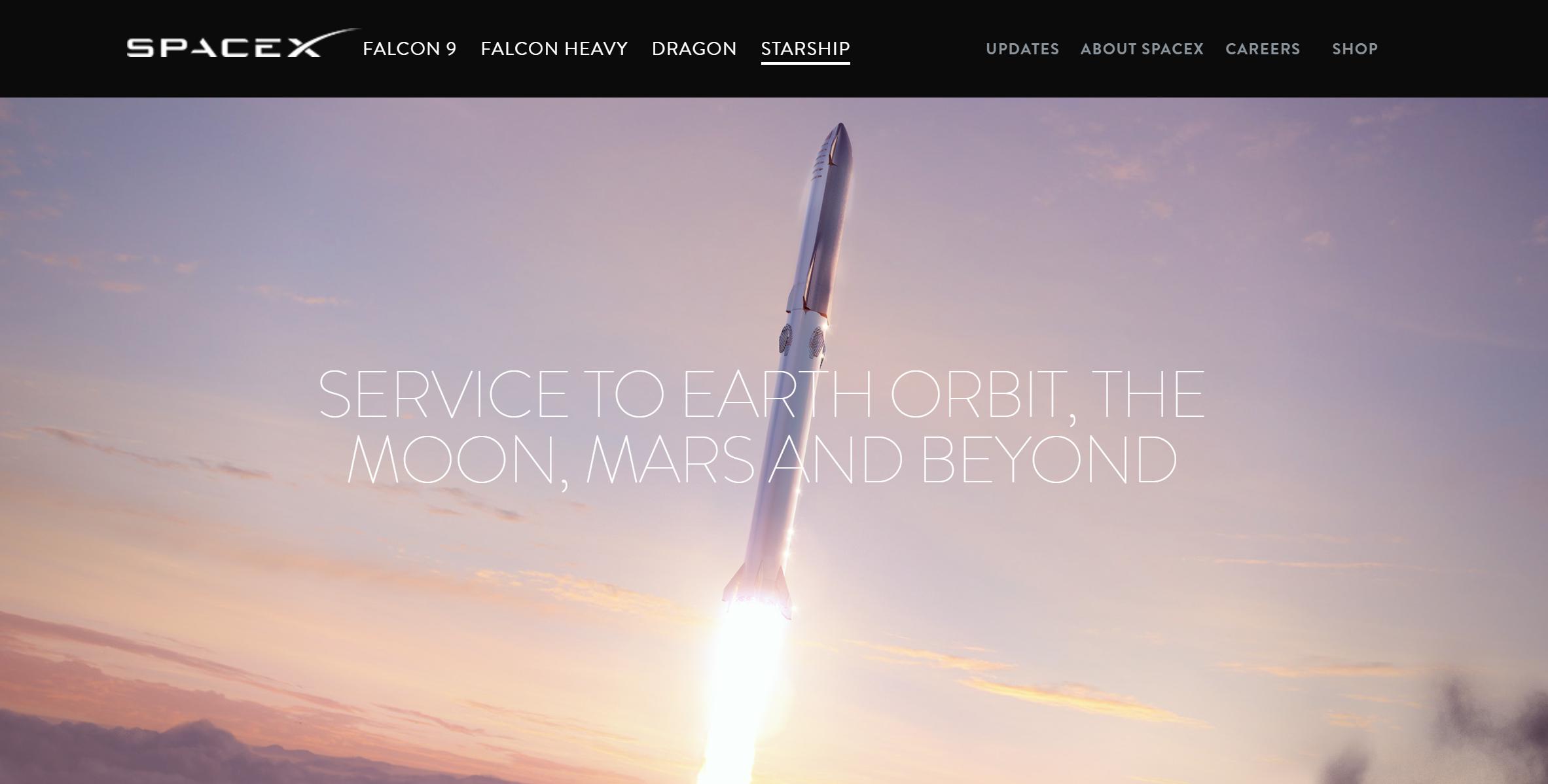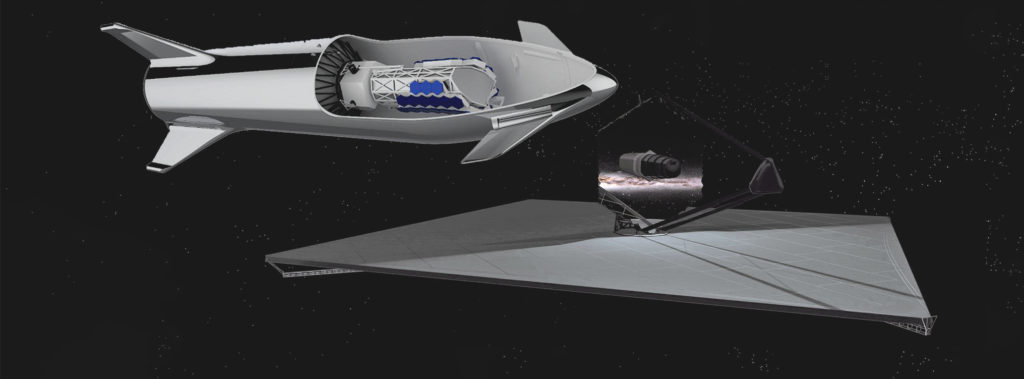

News
SpaceX publishes dedicated Starship webpage after Elon Musk’s presentation
Shortly after CEO Elon Musk’s 2019 presentation, SpaceX has published a new webpage dedicated to the next-generation Starship launch vehicle and its Super Heavy booster, detailing the rocket and providing some excellent new images and renders.
Beyond the images of Raptor and renders of Starship and Super Heavy, the webpage discusses several possible use-cases in Earth orbit and throughout the solar system, showing off the latest iteration of a cargo-focused Starship and teasing possible missions to the Space Station.
Known informally as “Chomper” in the spaceflight community, a cargo-optimized Starship would replace the pressurized crew section with a vast cargo bay and actuating door, the source of its nickname. Similar to but slightly simpler than the Space Shuttle’s famous clamshell doors, such a nose could be extremely useful. Although it could obviously be used to place massive payloads in orbit, a sealable cargo section could also be used to grab similarly large items on orbit and then either return them to Earth or service/repair them in situ.

Of note, NASA’s Goddard Space Flight Center (GSFC) – responsible for the proposed LUVOIR super-telescope – has already seriously begun considering a cargo-optimized Starship as one of a handful of possible launch options. In the event that LUVOIR is chosen for development by NASA, the massive space telescope could be ready for launch sometime in the 2030s, at which point GSFC believes there will be only three plausible options – NASA’s SLS, Blue Origin’s New Glenn, or SpaceX’s Starship.

According to LUVOIR’s extensively detailed “Final Report”, published less than a month ago, GSFC worked fairly closely with SpaceX to determine where exactly Starship might fit into the picture. Intriguingly, an April 2019 tweet from the Center revealed that SpaceX had verified that Starship would be able to launch LUVOIR-B, a smaller and simpler version of the telescope. The August 2019 report, however, reveals that Starship could also launch LUVOIR-A – the full-sized telescope – with just a few slight modifications to Starship’s payload section.

SpaceX acknowledged Starship’s already well-known potential for transporting cargo and crew to the Moon and Mars, but also noted that the massive spacecraft could be used to deliver cargo and crew to the International Space Station (ISS) or elsewhere in Earth orbit. The ISS is undeniably large but Starship is (relatively) even bigger, nominally featuring enough pressurized volume (~1000m3 vs ~910m3) to more than double the habitable capacity of the ISS upon arrival. CEO Elon Musk noted this in an offhand remark on September 28th, cognizant of the fact that a Starship on its own is effectively a reusable ISS-class space station that can be placed in orbit with a single launch.
If a given Starship can support a crew of astronauts over a multi-month interplanetary cruise, the same Starship can also – and probably even more easily so – serve as an all-in-one space station with months of longevity. Add in Starship-enabled resupply and refueling runs and SpaceX could likely sustain a fleet of autonomous space stations in Earth orbit with relative ease. Assuming SpaceX is interested, Starship launch prices are low enough, and a large enough market exists, Starship could almost instantly and singlehandedly take orbital tourism from a distant fantasy for billionaires to a serious market potentially accessible to hundreds of thousands or even millions of people.
Musk has noted in previous SpaceX presentations that the goal is to make Starship so reusable that the price of per-person tickets to Mars becomes comparable to buying a house ($500k to $1m). Assuming SpaceX gets close to that price target, the cost of a 100-person mission low Earth orbit – likely requiring just one launch – could potentially be comparable to buying a car (~$50,000).
Check out Teslarati’s Marketplace! We offer Tesla accessories, including for the Tesla Cybertruck and Tesla Model 3.
News
Tesla begins Robotaxi certification push in Arizona: report
Tesla seems serious about expanding its Robotaxi service to several states in the coming months.

Tesla has initiated discussions with Arizona transportation regulators to certify its driverless Robotaxi service in the state, as per a recent report from Bloomberg News. The move follows Tesla’s launch of its Robotaxi pilot program in Austin, Texas, as well as CEO Elon Musk’s recent comments about the service’s expansion in the Bay Area.
The Arizona Department of Transportation confirmed to Bloomberg that Tesla has reached out to begin the certification process for autonomous ride-sharing operations in the state. While details remain limited, the outreach suggests that Tesla is serious about expanding its driverless Robotaxi service to several territories in the coming months.
The Arizona development comes as Tesla prepares to expand its service area in Austin this weekend, as per CEO Elon Musk in a post on X. Musk also stated that Tesla is targeting the San Francisco Bay Area as its next major market, with a potential launch “in a month or two,” pending regulatory approvals.
Tesla first launched its autonomous ride-hailing program on June 22 in Austin with a small fleet of Model Y vehicles, accompanied by a Tesla employee in the passenger seat to monitor safety. While still classified as a test, Musk has said the program will expand to about 1,000 vehicles in the coming months. Tesla will later upgrade its Robotaxi fleet with the Cyercab, a two-seater that is designed without a steering wheel.
Sightings of Cybercab castings around the Giga Texas complex suggests that Tesla may be ramping the initial trial production of the self-driving two-seater. Tesla, for its part, has noted in the past that volume production of the Cybercab is expected to start sometime next year.
In California, Tesla has already applied for a transportation charter-party carrier permit from the state’s Public Utilities Commission. The company is reportedly taking a phased approach to operating in California, with the Robotaxi service starting with pre-arranged rides for employees in vehicles with safety drivers.
News
Tesla sets November 6 date for 2025 Annual Shareholder Meeting
The automaker announced the date on Thursday in a Form 8-K.

Tesla has scheduled its 2025 annual shareholder meeting for November 6, addressing investor concerns that the company was nearing a legal deadline to hold the event.
The automaker announced the date on Thursday in a Form 8-K submitted to the United States Securities and Exchange Commission (SEC). The company also listed a new proposal submission deadline of July 31 for items to be included in the proxy statement.
Tesla’s announcement followed calls from a group of 27 shareholders, including the leaders of large public pension funds, which urged Tesla’s board to formally set the meeting date, as noted in a report from The Wall Street Journal.
The group noted that under Texas law, where Tesla is now incorporated, companies must hold annual meetings within 13 months of the last one if requested by shareholders. Tesla’s previous annual shareholder meeting was held on June 13, 2024, which placed the July 13 deadline in focus.
Tesla originally stated in its 2024 annual report that it would file its proxy statement by the end of April. However, an amended filing on April 30 indicated that the Board of Directors had not yet finalized a meeting date, at least at the time.
The April filing also confirmed that Tesla’s board had formed a special committee to evaluate certain matters related to CEO Elon Musk’s compensation plan. Musk’s CEO performance award remains at the center of a lengthy legal dispute in Delaware, Tesla’s former state of incorporation.
Due to the aftermath of Musk’s legal dispute about his compensation plan in Delaware, he has not been paid for his work at Tesla for several years. Musk, for his part, has noted that he is more concerned about his voting stake in Tesla than his actual salary.
At last year’s annual meeting, TSLA shareholders voted to reapprove Elon Musk’s compensation plan and ratified Tesla’s decision to relocate its legal domicile from Delaware to Texas.
Elon Musk
Grok coming to Tesla vehicles next week “at the latest:” Elon Musk
Grok’s rollout to Tesla vehicles is expected to begin next week at the latest.

Elon Musk announced on Thursday that Grok, the large language model developed by his startup xAI, will soon be available in Tesla vehicles. Grok’s rollout to Tesla vehicles is expected to begin next week at the latest, further deepening the ties between the two Elon Musk-led companies.
Tesla–xAI synergy
Musk confirmed the news on X shortly after livestreaming the release of Grok 4, xAI’s latest large language model. “Grok is coming to Tesla vehicles very soon. Next week at the latest,” Musk wrote in a post on social media platform X.
During the livestream, Musk and several members of the xAI team highlighted several upgrades to Grok 4’s voice capabilities and performance metrics, positioning the LLM as competitive with top-tier models from OpenAI and Google.
The in-vehicle integration of Grok marks a new chapter in Tesla’s AI development. While Tesla has long relied on in-house systems for autonomous driving and energy optimization, Grok’s integration would introduce conversational AI directly into its vehicles’ user experience. This integration could potentially improve customer interaction inside Tesla vehicles.
xAI and Tesla’s collaborative footprint
Grok’s upcoming rollout to Tesla vehicles adds to a growing business relationship between Tesla and xAI. Earlier this year, Tesla disclosed that it generated $198.3 million in revenue from commercial, consulting, and support agreements with xAI, as noted in a report from Bloomberg News. A large portion of that amount, however, came from the sale of Megapack energy storage systems to the artificial intelligence startup.
In July 2023, Musk polled X users about whether Tesla should invest $5 billion in xAI. While no formal investment has been made so far, 68% of poll participants voted yes, and Musk has since stated that the idea would be discussed with Tesla’s board.
-

 Elon Musk1 week ago
Elon Musk1 week agoTesla investors will be shocked by Jim Cramer’s latest assessment
-

 Elon Musk20 hours ago
Elon Musk20 hours agoxAI launches Grok 4 with new $300/month SuperGrok Heavy subscription
-

 Elon Musk3 days ago
Elon Musk3 days agoElon Musk confirms Grok 4 launch on July 9 with livestream event
-

 News7 days ago
News7 days agoTesla Model 3 ranks as the safest new car in Europe for 2025, per Euro NCAP tests
-

 Elon Musk2 weeks ago
Elon Musk2 weeks agoA Tesla just delivered itself to a customer autonomously, Elon Musk confirms
-

 Elon Musk1 week ago
Elon Musk1 week agoxAI’s Memphis data center receives air permit despite community criticism
-

 Elon Musk2 weeks ago
Elon Musk2 weeks agoTesla’s Omead Afshar, known as Elon Musk’s right-hand man, leaves company: reports
-

 News2 weeks ago
News2 weeks agoXiaomi CEO congratulates Tesla on first FSD delivery: “We have to continue learning!”

















